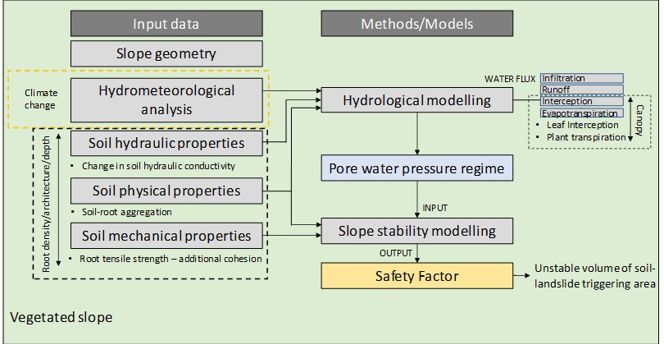Modelling the Hydro-Mechanical Effects of Several Riparian Vegetation Combinations on the Streambank Stability – a benchmark case in Southeastern Norway

A new study conducted by the Department of Natural Hazards – Norwegian Geotechnical Institute NGI – has been published in the journal “Sustainability”.
The work proposes a methodological approach when assessing slope stability including vegetation effects.
The role of several riparian vegetation combinations on streambank stability is then analyzed with the proposed approach. The analyses were carried out for critical shallow shear planes of ideal benchmark slopes covered with four different plant combinations—(i) only grass, (ii) grass and shrubs, (iii) only trees, and (iv) trees, shrubs, and grass—for species typically found along streams in southeastern Norway.
In this desk study, two types of tree species were selected, namely Norway spruce (Picea abies) and Downy birch (Betula pubescens). The Goat willow (Salix caprea) was selected as a shrub, while a common mixed-grass was chosen as grass.
Methodology
In the methodological approach, all the effects of vegetation to the change of soil parameters or the main hydrological processes are identified and categorized, based on whether they are a function of the root features (mostly density, architecture and depth) or the canopy (type of aboveground vegetation). The methodology was used for two main cases: (1) considering only the mechanical contribution of vegetation and (2) considering both the hydrological and mechanical reinforcement of vegetation.
For the second case, two different simulations were carried out respectively for May and October, as representative months respectively for the spring season and the fall season.
In May, the vegetation thrives, so it has its maximum effect on the slope stability, while in October, the vegetation is still present but has lost part of its effectiveness in improving the slope stability, partly because of the climate conditions (higher relative humidity, lower temperature) and partly due to the onset of autumn where plants begin shedding foliage.

Methodological approach for slope stability modeling including vegetation–soil parameters and processes influenced by the presence of vegetation (root density/architecture/depth and canopy area).
Main results
The main outcome of the numerical modelling showed that the purely mechanical contribution of vegetation to slope stability could not be decoupled from the hydrological reinforcement in order to have a realistic assessment of the roots improvement to the stability. The most critical shear surfaces occurred below the rooted zone in all cases, and the best performance was obtained using the combinations including trees.
Considering the typical climate conditions in Norway, the hydro-mechanical reinforcement was most effective in the spring and for combinations including low height vegetation (i.e., grass and shrubs). The study concludes that a mixed combination of vegetation (trees, shrubs, and grass) is the most suitable for reaching the highest hydro-mechanical reinforcement of streambanks, together with erosion protection and boosting the ecosystem biodiversity.
The current study can help practitioners determine which vegetation cover combination is appropriate for improving the current stability of a streambank with restoration practices.
Source
The work has been published as part of the Special Issue “Sustainable Use of Nature-Based Solutions for Erosion Control and Slope Protection” and is available online:
Open access article: https://www.mdpi.com/2071-1050/13/7/4046/htm
Contact person from PlaNet: Vittoria Capobianco (NGI); vittoria.capobianco@ngi.no